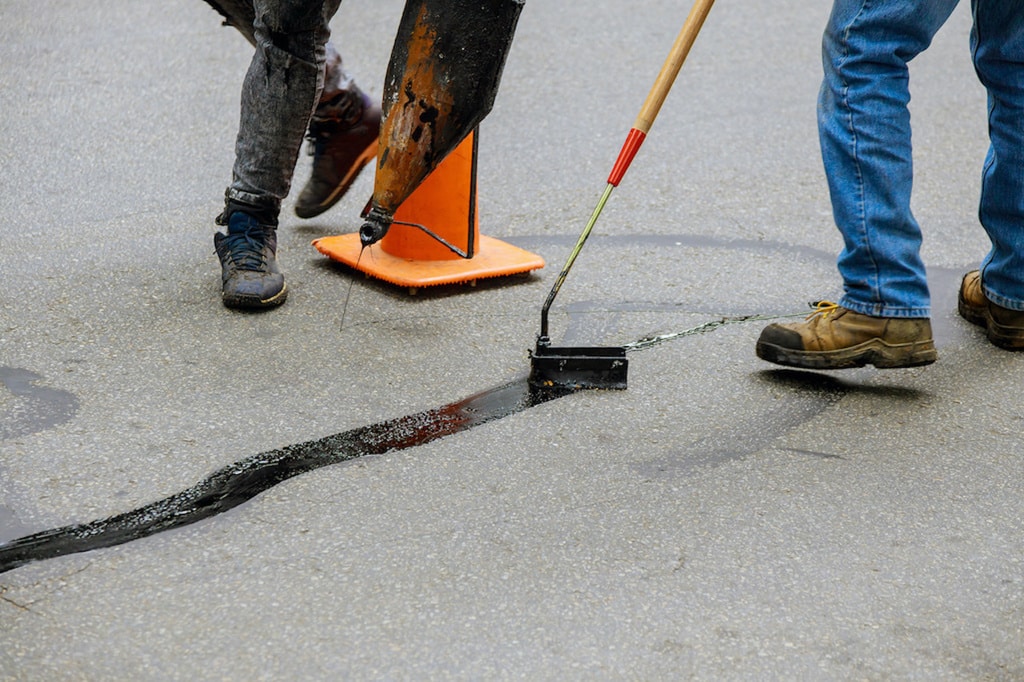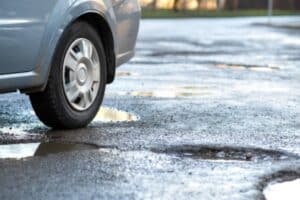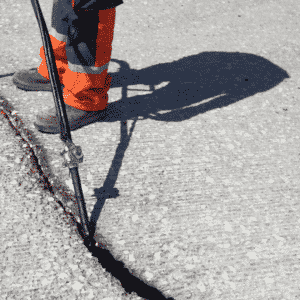Property managers and facilities managers need to be aware of asphalt cracks on their property. They also need to make sure that asphalt cracks are maintained with crack sealing. What is crack sealing? Crack sealing is the sealing of cracks and gaps in asphalt driveways, roads, and parking lots with a hot-applied rubberized crack sealant. The crack sealant prevents water from getting into the crack, which helps to prevent potholes and other damage to your pavement. This article will discuss what crack sealing entails, how it works, and best practices for a property manager.
What is crack sealing?
Crack sealing is a crack filler for cracks and gaps in asphalt. The crack sealant material seals against water — the biggest threat to asphalt pavements. When water flows into cracks, it leads to potholes, alligator cracking, and other asphalt damage. While seal cracking can help stave off crack formation, nothing is 100% effective in preventing asphalt cracks. So, the faster you act on it, the less damage they will do to your asphalt. A rubberized sealant can seal the gaps and keep water and other debris out of the aggregate base layer. However, knowing what causes asphalt cracking may assist you in better preparing for and taking required measures when cracks happen.
Causes of asphalt cracking:
- Sunlight –– UV rays from the sun will cause asphalt pavements to age. The UV radiation causes the asphalt pavement to become progressively more brittle over time due to oxidation. When exposed to traffic loads or seasonal changes, aged, brittle asphalt may crack much easier.
- Changing seasons –– seasonal changes, such as the transition from fall to winter, can generate large swings in temperature. When the temperature drops rapidly, the asphalt shrinks too quickly, causing a thermal fracture to develop. When the temperature changes frequently, pavements are more prone to thermal cracking. Furthermore, the transition from winter to spring has its own set of difficulties. As snow, frost, and ice begin to melt away, water may be trapped between the pavement and the still-frozen soil beneath it. As a result, when water levels in the aggregate base and subgrade soil rise above the critical saturation point, their strength decreases and becomes more susceptible to fractures from vehicle traffic.
- Traffic – Asphalt’s flexibility allows the pavement to bend as vehicles drive over it, and a tiny amount of damage is done each time it bends. A heavier vehicle causes more damage than a lighter one, and old asphalt pavements are damaged by traffic more than new asphalt pavements. In addition, even worse damage can be caused to the pavement by a saturated, weaker aggregate base and subsoils due to the changing seasons. Eventually, these repeats of minor damage build up and cause the asphalt pavement to crack and break up.
Read More: Why Asphalt Cracks Form
Why crack seal asphalt?
Crack sealing is necessary because it prevents water from getting into the crack, which helps prevent potholes and other damage to your pavement. It can be done by yourself or with professionals depending on what you are comfortable with.
However, it’s also the first step in a more extensive process called pavement preservation. Pavement preservation can help prolong the life of your asphalt driveways/parking lots by preventing damage that could lead to costly repairs later down the road.
How does crack sealing work?
A crack-filling machine uses a piston to draw the crack sealant from a vat or drum and force it into the crack. This process helps ensure that there is enough aggregate in the crack to support vehicle traffic.
The hot crack filling material bonds to the surrounding asphalt, the entire depth of the crack. The seal is maintained between the crack sealant and the pavement on either side of the crack because it’s very elastic. Rubberized crack seal material can stretch and contract along with the asphalt pavement during the thermal cycle.
When to Crack Seal Asphalt
Cracks are big enough to seal when they are bigger than 1/8th inch wide. They should be sealed as soon as possible to avoid asphalt damage. Any time of year is a suitable time to crack seal if it is dry. But, because crack seal typically takes a few hours to dry, it’s best to ensure that there is no rain or inclement weather in the forecast. Additionally, crack sealing is an ongoing process. Once a crack has been sealed, it’s only a matter of time before it will need to be sealed again.
Read More: Cracked Asphalt: When to Seal vs. Repair
9 Crack Sealing Tips for Property Managers
As a property manager in charge of multiple asphalt driveways and parking lots, the scope of asphalt maintenance tasks you must oversee can be overwhelming. To help focus your crack sealing efforts, here are a few crack seal tips for property managers, HOAs, and facilities managers.
1. A good crack seal should last at least 1 year.
Many variables determine how long a crack seal lasts, but it is typical that asphalt crack sealants are applied about every 18 months to 2 years. So, plan and budget accordingly.
Read More: How Often to Crack Seal Asphalt
2. Keep cracks clear of debris.
Before cracks can be sealed, they should be monitored and cleared of debris such as grass clippings or leaves, which could get packed into the crack. Moreover, in the best-case scenario, crack sealing should be done before the crack gets filled with other materials, such as dirt and gravel, which speed up erosion.
3. Watch for standing water.
Property managers can help by ensuring no standing water on the pavement before the crack sealing season begins. The same holds for snow and ice.
4. Crack seal before winter.
It’s critical to seal asphalt cracks before the winter. Water seeps into active fractures, where it rests beneath the asphalt. During the cold months, as a result of this water, ice forms in the cracks and pores of the pavement. As the ice melts, the water thaws, causing it to expand and compress over and over. As a result of this motion, pressure is applied to the pavement from below. The surface may appear safe in the spring, but it can easily fracture and change into a pothole later on.
Additionally, crack sealing schedules can fill up, so be sure to contact your crack sealing contractor ahead of time.
5. Sealcoat to help ward off cracks.
Sealcoating is an asphalt maintenance treatment that prolongs the life of asphalt by providing a protective coating across the entire pavement surface. Seal coat also fills in small cracks, hairline cracks, and small voids in the pavement surface. Sealcoating doesn’t effectively fill cracks wider than about 1/8th of an inch.
Read More: The Complete Guide to Sealcoating for Property Managers and HOAs
6. Warn tenants ahead of time.
To help get your parking lots cleared on your date of service, be sure to warn tenants of the upcoming asphalt maintenance. It helps to let them know how the crack seal service benefits them: preventing potholes and damage to their cars. Add a section to your flyer and any email messaging about it.
7. Rope off parking lots early.
Make sure to rope off your parking area to traffic before the asphalt maintenance team arrives. This is the best way to make sure your service goes as quickly as possible. And a faster service means getting your parking lot back ASAP.
8. Make sure sealant has cured before opening to traffic.
Asphalt that has been crack sealed can be opened to walking traffic within a few hours. However, it’s best to give the crack sealing treatment a full day before opening up your parking lot or driveway to car and foot traffic again. This will ensure that the crack sealant has had enough time to cure completely and won’t be easily disturbed by heavy automotive traffic (and potential damage).
9. Be aware of crack sealant material settling.
Lastly, keep in mind that sometimes there are dips in the crack seal where it hasn’t been filled completely — don’t be alarmed! The crack is still sealed. However, the rubberized crack seal has settled down into the gap. As long as the sealant is stuck to both sides of the crack and has settled into the gap, the crack is still sealed off from the elements.
Asphalt Crack Sealing Professionals
While there are many DIY asphalt crack sealing solutions, DIY isn’t always the best option — especially for property managers and facilities managers in charge of large parking lots and multiple properties.
At Superior Asphalt, LC, we have the industrial crack sealing equipment, professional-grade crack seal material, and crack sealing experience to seal parking lot cracks properly and effectively, at scale.
Our team of Utah crack sealing professionals evaluates issues related to pavement cracks and treats them appropriately. First, we assess crack width, length, and depth to determine the extent of the damage. Then we will advise you on what steps should be taken next for a lasting solution. Contact us today to get started!
Read More:





